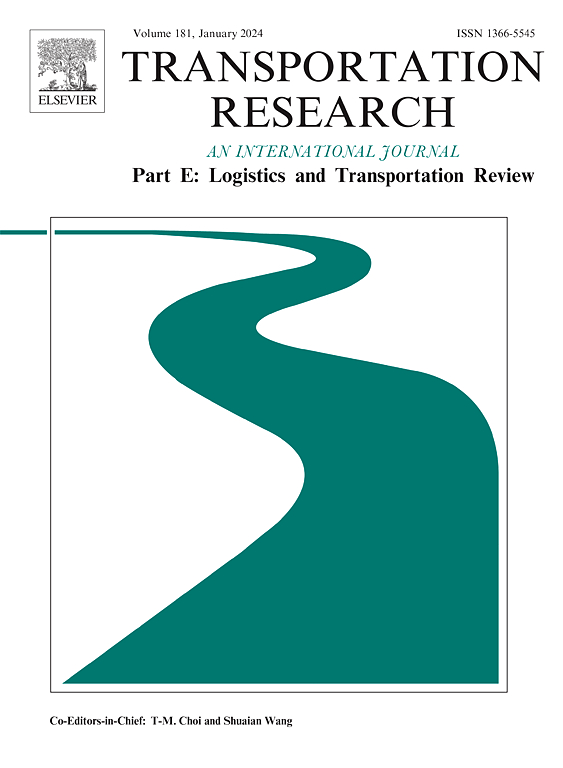双寡头竞争下运输市场价格歧视的规制
IF 8.3
1区 工程技术
Q1 ECONOMICS
Transportation Research Part E-Logistics and Transportation Review
Pub Date : 2025-05-08
DOI:10.1016/j.tre.2025.104127
引用次数: 0
摘要
随着平台经济和大数据技术的显著发展,服务提供商可以实施高度针对性的歧视性定价策略,例如对相同产品的新老客户收取不同的价格。这种做法引起了对公平和消费者保护的重大关注。受这些现实世界观察的启发,我们开发了一个两期定价竞争模型。我们的模型模拟了一个场景,在第1阶段,两个异质供应商最初在价格上竞争以吸引客户。在第二阶段,他们试图通过为剩余资源提供更低的价格来吸引观望客户。采用考虑客户异质性和供需拥堵效应的Hotelling框架来捕捉客户的战略决策过程,并将两个独立的时期整合起来。为了规范价格歧视,在阶段2开始时施加价格权益约束,以缩小现有客户和观望客户之间的价格差距。为了量化这项规定的影响,我们利用香港的停车数据进行了一项数值研究,考察了消费者剩余和社会福利的变化。我们的研究结果表明,适当的股权监管水平可以激励消费者从优势供应商转向劣势供应商,从而促进更具竞争力的市场,降低垄断风险。相反,过于严格的价格公平监管可能会产生意想不到的负面后果,可能会降低整体社会福利。本文章由计算机程序翻译,如有差异,请以英文原文为准。
Regulation of price discrimination in the transportation market under duopoly competition
With significant advancements in platform economy and big data technologies, service providers can implement highly targeted discriminatory pricing strategies, as exemplified by charging different prices to fresh and frequent customers for identical products. This practice raises significant concerns about fairness and consumer protection. Motivated by these real-world observations, we develop a two-period pricing competition model. Our model simulates a scenario where two heterogeneous suppliers initially compete on price to attract customers in period 1. In period 2, they attempt to attract wait-and-see customers by offering lower prices for their remaining resources. A Hotelling framework accounting for customer heterogeneity and supply–demand congestion effects is used to capture customers’ strategic decision-making process and integrate the two separate periods. To regulate price discrimination, a price equity constraint is imposed at the beginning of period 2 to narrow the price gap between existing and wait-and-see customers. To quantify the impact of this regulation, we conduct a numerical study using car parking data from Hong Kong, examining changes in consumer surplus and social welfare. Our findings reveal that an appropriate level of equity regulation can incentivize customers to switch from advantaged to disadvantaged suppliers, fostering a more competitive market and mitigating the risk of monopolies. Conversely, excessively stringent price equity regulations can have unintended negative consequences, potentially diminishing overall social welfare.
求助全文
通过发布文献求助,成功后即可免费获取论文全文。
去求助
来源期刊
CiteScore
16.20
自引率
16.00%
发文量
285
审稿时长
62 days
期刊介绍:
Transportation Research Part E: Logistics and Transportation Review is a reputable journal that publishes high-quality articles covering a wide range of topics in the field of logistics and transportation research. The journal welcomes submissions on various subjects, including transport economics, transport infrastructure and investment appraisal, evaluation of public policies related to transportation, empirical and analytical studies of logistics management practices and performance, logistics and operations models, and logistics and supply chain management.
Part E aims to provide informative and well-researched articles that contribute to the understanding and advancement of the field. The content of the journal is complementary to other prestigious journals in transportation research, such as Transportation Research Part A: Policy and Practice, Part B: Methodological, Part C: Emerging Technologies, Part D: Transport and Environment, and Part F: Traffic Psychology and Behaviour. Together, these journals form a comprehensive and cohesive reference for current research in transportation science.

 求助内容:
求助内容: 应助结果提醒方式:
应助结果提醒方式:


